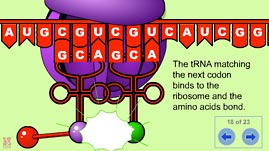Teachers' Domain - Digital Media for the Classroom and Professional Development
User: Preview

Source: University of Nebraska, Institute of Agriculture and Natural Resources
This interactive activity adapted from the University of Nebraska provides an overview of protein synthesis as well as a more detailed look at two critical phases of the process: transcription and translation. DNA provides the necessary instructions for life, and protein synthesis is the process by which DNA's instructions are enacted.
The function of DNA in the living world is at once bafflingly complex and surprisingly simple. The genetic code carried in molecules of DNA is responsible for a stunning variety of life forms. Orchids in the Amazon, tubeworms on the ocean floor, and giraffes on the Serengeti have all arisen, and survive and thrive in their respective environments, because of the function of DNA.
Inside every living cell, DNA directs vital activities, such as growth, division, movement, respiration, and even death, by providing the instructions that cells use to build proteins. DNA gives rise to the physical and behavioral adaptations that make organisms unique. And yet, the chemical language in which DNA's instructions are written is stunningly simple. It consists of just four letters, which correspond to the four functional molecules, called nucleotides, from which DNA is built: adenine (A), thymine (T), cytosine (C), and guanine (G). Particular sequences of these four molecules function as genes by providing the instructions required to build one or more proteins.
The DNA molecule resembles a twisted ladder, with pairs of nucleotides forming the ladder's rungs. As a rule, adenine always pairs with thymine and cytosine with guanine. When a cell requires a particular protein, an activation signal stimulates the release of an enzyme called RNA polymerase, which causes the DNA to "unzip" between nucleotide pairs in the region of the appropriate gene. As the RNA polymerase molecule moves along one of the unzipped DNA strands, it assembles a similar nucleic acid molecule, known as messenger RNA (mRNA), using free nucleotides found inside the nucleus. The mRNA molecule is a mirror image of the DNA strand that is being read, except that the nucleotide uracil (U) is substituted for thymine. This is called transcription. After this process is complete, the mRNA is transported outside the nucleus to the cytoplasm, where it can be translated into a protein.
Structures found in the cytoplasm, called ribosomes, perform the process of translation, in which amino acid chains, or proteins, are assembled based on mRNA code. Ribosomes read mRNA nucleotides three at a time. Each mRNA triplet, called a codon, corresponds to a particular amino acid or provides the signal that tells the ribosome to begin or stop translation. As it reads the mRNA codons, the ribosome attaches amino acids to each other in a chain that corresponds to those codons. When the ribosome reaches a "stop codon," translation ceases and the ribosome releases the finished protein.
 Loading Standards
Loading Standards Teachers' Domain is proud to be a Pathways portal to the National Science Digital Library.
Teachers' Domain is proud to be a Pathways portal to the National Science Digital Library.
